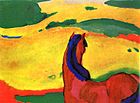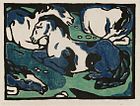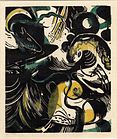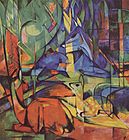- Franz Marc
-
Franz Marc 
Plaque on the house where Marc was bornBorn 8 February 1880
Munich, Bavaria, German EmpireDied 4 March 1916 (aged 36)
Braquis, FranceNationality German Field Painting Training Academy of Fine Arts, Munich Movement Expressionism Works Fate of the Animals, Tiger, The Yellow Cow, Fighting Forms Franz Marc (February 8, 1880 – March 4, 1916) was a German painter and printmaker, one of the key figures of the German Expressionist movement. He was a founding member of Der Blaue Reiter (The Blue Rider), a journal whose name later became synonymous with the circle of artists collaborating in it.
Contents
Early life and education
Franz Marc was born in 1880 in Munich, then the capital of the Kingdom of Bavaria. His father, Wilhelm, was a professional landscape painter, and his mother Sophie was a strict Calvinist. In 1900, Marc began to study at the Academy of Fine Arts, Munich, where his teachers would include Gabriel von Hackl and Wilhelm von Diez. In 1903 and 1907 he spent time in France, particularly in Paris, visiting the city's museums and copying many paintings, a traditional way that artists studied and developed technique. In Paris, Marc frequented artistic circles, and was able to meet numerous artists, including the actress Sarah Bernhardt. He discovered a strong affinity for the work of Vincent van Gogh.
Marriage and family
During his 20s, Marc was involved in a number of stormy relationships, including a years-long affair with Annette von Eckardt, a married antique dealer who was nine years his elder. He married twice, first to Marie Schnuer, then to Maria Franck.
Career
In 1906, Marc traveled with his elder brother Paul, a Byzantine expert, to Saloniki, Mount Athos, and various other Greek locations. A few years later in 1910, Marc developed an important friendship with the artist August Macke.
In 1911 Marc founded the Der Blaue Reiter journal, which became the center of an artist circle with Macke, Wassily Kandinsky, and others who decided to split off from the Neue Künstlervereinigung (New artist's association) movement.
Marc showed several of his works in the first Der Blaue Reiter exhibition at the Thannhauser Galleries in Munich between December 1911 and January 1912. The apex of the German expressionist movement, the exhibit also showed in Berlin, Köln, Hagen, and Frankfurt. In 1912, Marc met Robert Delaunay, whose use of color and futurist method was a major influence on Marc's work. Fascinated by futurism and cubism, Marc created art increasingly stark and abstract in nature.
After mobilization of the German Army during World War I, the government identified notable artists to be withdrawn from combat to protect them. Marc was on the list, but before orders for reassignment could reach him, he was struck in the head and killed instantly in 1916 by a shell splinter during the Battle of Verdun.[1]
Style
Marc made some sixty prints, in woodcut and lithography. Most of his mature work portrays animals, usually in natural settings. His work is characterized by bright primary color, an almost cubist portrayal of animals, stark simplicity and a profound sense of emotion. His work attracted notice in influential circles even in his own time. Marc gave an emotional meaning or purpose to the colors he used in his work: blue was used for masculinity and spirituality, yellow represented feminine joy, and red encased the sound of violence. After the National Socialists took power, they suppressed modern art; in 1936 and 1937, the Nazis condemned Marc as an entarteter Künstler' (degenerate artist), and ordered that approximately 130 of his works be taken from exhibit in German museums.
Franz Marc's best-known painting is probably Tierschicksale (also known as Animal Destinies or Fate of the Animals), which hangs in the Kunstmuseum Basel. Marc completed the work in 1913, when "the tension of impending cataclysm had pervaded society", as one art historian noted.[2] On the rear of the canvas, Marc wrote, "Und Alles Sein ist flammend Leid" ("And all being is flaming agony").[2][3] Conscripted during World War I, Marc wrote to his wife of the painting, it "is like a premonition of this war--horrible and shattering. I can hardly conceive that I painted it."[2]
Legacy and honors
- His family house in Munich is marked with an historic plaque.
- In October 1998, several of Marc's paintings garnered record prices at Christie's art auction house in London, including Rote Rehe I (Red Deer I), which sold for $3.30m.
- In October 1999, his Der Wasserfall (The Waterfall) was sold by Sotheby's in London to a private collector for $5.06m. This price set a record for both Franz Marc's work, and 20th-century German painting.
-
Horse in a Landscape, Museum Folkwang, Essen, 1910
-
Die großen blauen Pferde (The Large Blue Horses), Walker Art Center, 1911
-
Schlafende Hirtin, 1912, British Museum
-
Horses Resting, 1911-1912, Museum of Fine Arts, Boston
-
Aus der Tierlegende, 1912, British Museum
-
Versöhnung (Atonement), 1912, Museum of Fine Arts, Boston
-
The Bewitched Mill, 1913, Art Institute of Chicago
-
Birth of the Wolves, 1913, Yale University Art Gallery
-
The Fate of the Animals, 1913, Kunstmuseum Basel
-
Schöpfungsgeschichte II, 1914, British Museum
-
Rehe im Walde (Roe deer in the forest), 1914
Notes
References
- Rosenthal, M. Franz Marc, Prestel, 2004. ISBN 3-7913-3094-2
- "Day of German and Austrian Art Sales at Sotheby's in London Raises £18,350,091" Sotheby's, October 6, 1999, retrieved September 4, 2006
External links
Authority control: VIAF: 44310294Der Blaue Reiter Leaders Wassily Kandinsky · Franz Marc
Artists See also Die Brücke · Expressionism Categories:- 1880 births
- 1916 deaths
- People from Munich
- People from the Kingdom of Bavaria
- German painters
- German Expressionist painters
- German printmakers
- Modern painters
- Expressionism
- German military personnel killed in World War I
- Academy of Fine Arts, Munich alumni
Wikimedia Foundation. 2010.
















